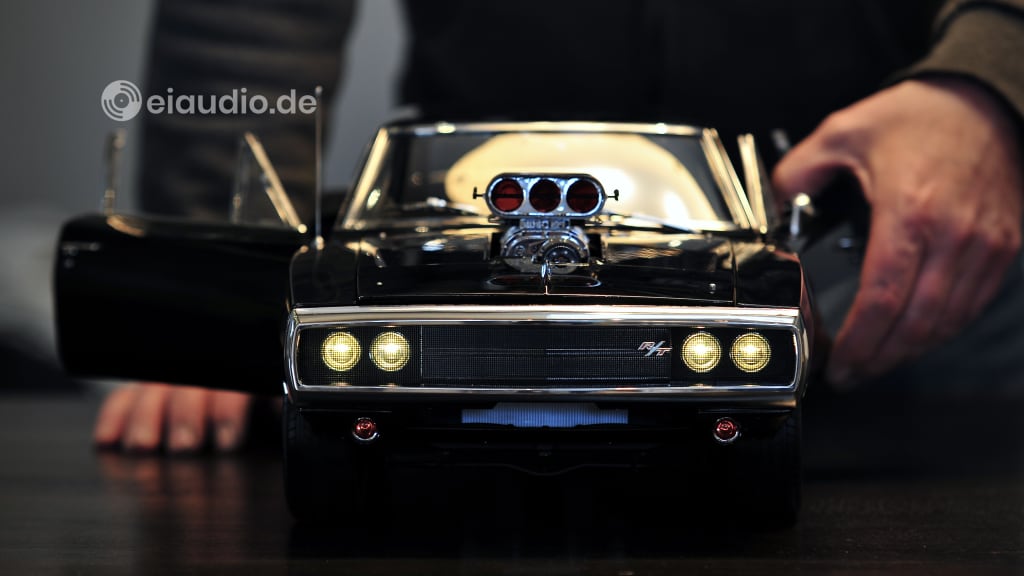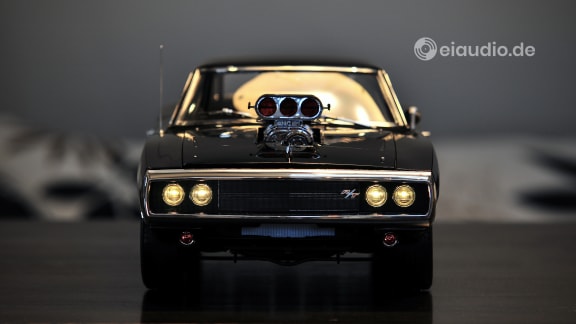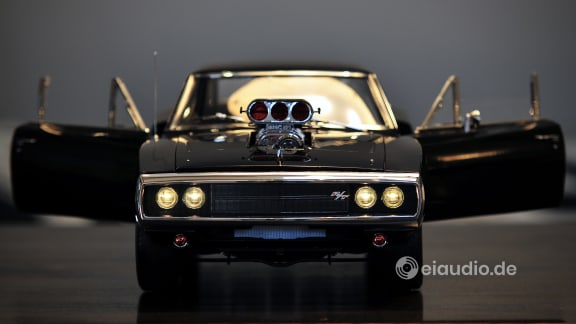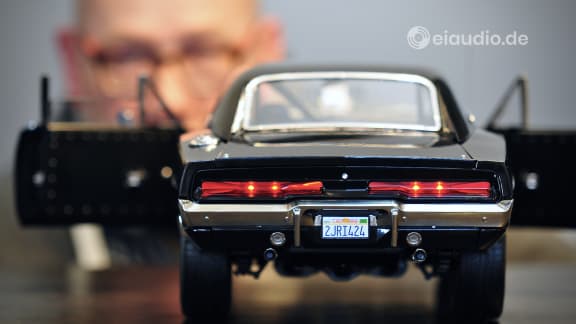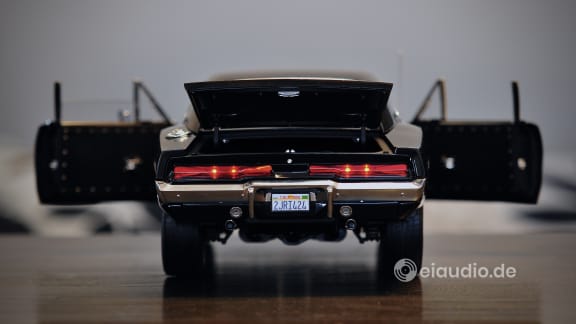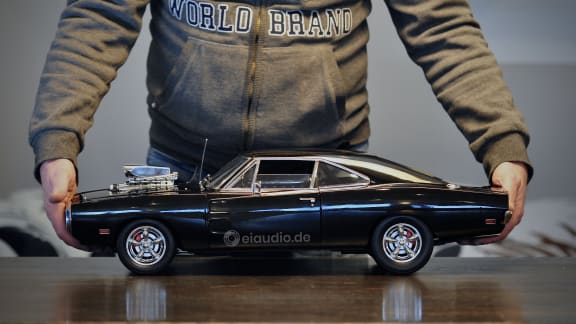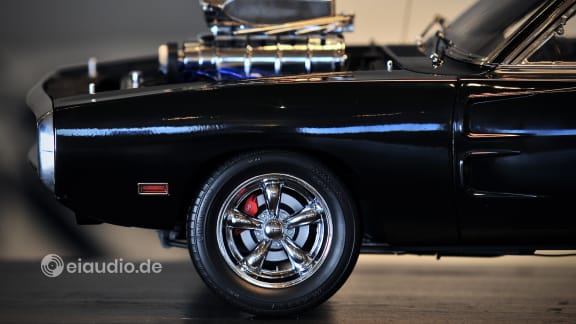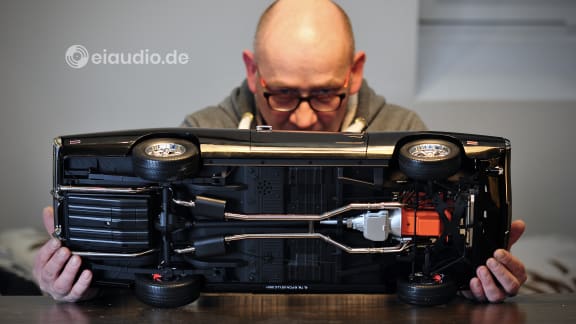Dodge Charger RT
Published: 23/01/2023
Author: Karsten Hein
Category: Explorations
Tag(s): Model Kit Cars
Right about the time that I started the eiaudio website, my good friend Thomas Kubalsky began his exploration of RC cars. At first, he purchased scale 1:24 army trucks on which he modified the drive trains, but it was not long until he discovered that far more sophisticated parts were available for larger models at the scale of 1:10 and beyond. Thomas owned a range of RC cars from modified racing models with brushless motors to souped-up crawlers, and it was the modification of crawlers that fascinated him most. He enjoyed the challenge of overcoming even the most difficult obstacles in the path of each vehicle through his engineering and driving skills. His modifications included the servo motors, engine, internal wiring, the lights, engines, and drive trains. For each hour of driving, Thomas spent at least three hours fixing, improving, or upgrading broken parts or maintaining his vehicles. In many ways, Thomas’ explorations were similar to mine, in the sense that the simple joy of listening or driving had long since been replaced by the hope and drive of new discovery. On many nights, Thomas and I spoke about the current state of our explorations and about the hopes and frustrations they entailed.
The 1970 Dodge Charger R/T from the movie The Fast & Furious was an unusual build project for Thomas, one that his girlfriend had brought along from her hometown in Thuringia. As it turned out, one of her brothers had been a collector of De Agustini assembly kit models for years and had collected all the 110 weekly issues of the De Agustini magazine to which a small number of car parts were attached each time. Sadly, the brother’s health had been deteriorating, and he was no longer able to complete the extensive build himself. With Thomas having developed a reputation of excellent model building skills, Katrin had filled some large bags and boxes with the magazine issues and carried them into Thomas’ living room, until almost a quarter of the floor space was covered with the new project. At first, Thomas and Katrin started the building project together, freeing the parts from each successive issue of the magazine, reading the instructions, and discussing the best procedure. But with each issue bringing along about one hour of work, Thomas proceeded to spend many days and nights completing the project on his own.
The amount of detail in this model was staggering, and much of it resembled the real-life car. Each spark plug and drum brake needed to be wired separately. The windows could be lowered by cranking the small leavers. The dashboard was lit, and a floor pedal ignited the tail lights. The iconic blower engine could be removed in order to allow a glimpse under the engine hood, revealing the 900 bhp Hemi racing engine underneath. The fun fact relating to the Hemi engine was that—although fully functional—it was never used for actually driving the Charger in the movie scenes. It was simply too powerful for the car structure, made it unstable while driving, and was able to twist the chassis against itself along the length of the car. Therefore, instead of the Hemi, the car’s original Chrysler RB-series V-8 440 Magnum engine was used in a slightly modified version. The original Dodge had been a heavy car to begin with, and, after about 110 hours of building, Thomas found that this was also true for the De Agustini model which weighed 9.2 kg. This design was in marked contrast to Thomas’ RC projects, on which the chassis was usually designed to be of reduced weight.
When Thomas called me to report that he had completed the car for Katrin’s brother and that he was about to return it to him, I felt the strong urge to preserve this exploration and to share it with the world. I admit that model cars do not have much to do with the subject of audio exploration. However, Thomas has been a staunch supporter of the eiaudio project over the years and helped me develop best practice procedures for the sanding of turntable covers and on other occasions. This article about his own successful and impressive project was a great way to return the favour.
Specifications
Model Version:
- Type: De Agustini collectors’ assembly kit
- Number of collectors’ issues: 110
- Model type: souped-up 1970 muscle car
- Dimensions: (L) 66cm; (W): 24cm; (H) 18cm
- Finished model weight: 9.2 kg
- Assembly: by Thomas Kubalsky, Germany
- Year: 2023
Movie Version
- Type: souped-up 1960-70 muscle car
- Starred in Film(s): The Fast & Furious
- Driver: "Dom" Toretto, played by actor Vin Diesel
- Vehicle appearances: in 7 out of 9 movies
- Vehicle base: 1969 Dodge Charger R/T
- Re-modeled: resembles 1970 Dodge Charger R/T
- Film engine shown: Hemi racing engine
- Hemi engine power: 900 bhp (working film prop)
- Hemi engine boost-power: 1,100 bhp
- Booster-type: Nitrous Oxide (N.O.S.)
- Supercharger: BDS 8-71 Roots
- Real film engine: 440 Magnum (for shooting)
- Vehicle suspension: made by Hotchkis
- Headlights: made by Hedman
- Brake disks: made by Wilwood
- Fuel pump: made by Holley
- Exhaust: made by Flowmaster
- Wheels type: Cragar 200-S
- Tires: Continental Sport Contact
- Year: 2001
1970 Dodge Charger R/T
- Type: muscle car coupé (2nd generation)
- Engine code: Chrysler RB-series V-8 440 Magnum
- Engine type: 16 valve V8 big-block (longitudinal, front)
- Engine capacity: 7,2 liter
- Horse power: 375 hp / 279 kW at 4,600 rpm
- Maximum torque: 654 Nm at 3,200 rpm
- Advised top speed: 70 mph
- Transmission: 4-speed manual
- Drive train: rear wheel drive
- Front/rear brake system: 279mm drums
- Front suspension: torsion bars with stabiliser
- Rear suspension: leaf springs with stabiliser
- Dimensions: (L) 529.6cm; (W) 194.6cm; (H) 134.6cm
- Curb weight: 1,760 kg
- Fuel tank capacity: 72l


